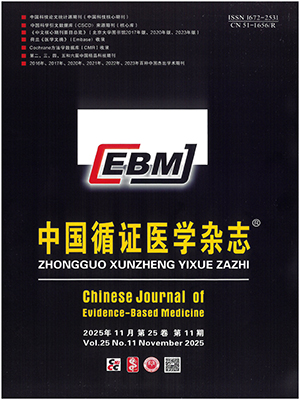| 1. |
Warlow CP, Van Gijn J, Dennis MS, et al. Stroke: practical management. New York: John Wiley & Sons, 2011.
|
| 2. |
GBD 2016 Epilepsy Collaborators. Global, regional, and national burden of epilepsy, 1990-2016: a systematic analysis for the global burden of disease study 2016. Lancet Neurol, 2019, 18(4): 357-375.
|
| 3. |
勵建安. 康復醫學. 北京: 人民衛生出版社, 2014: 216-217.
|
| 4. |
劉春英, 郭毅, 楊歡, 等. 腦卒中偏癱患者早期運動療法康復效果的系統評價. 中國循證醫學雜志, 2016, 16(2): 166-171.
|
| 5. |
Brazzelli M, Saunders DH, Greig CA, et al. Physical fitness training for patients with stroke: updated review. Stroke, 2012, 43(4): e39-e40.
|
| 6. |
曹雪亮. 腦力疲勞的注意特征及主觀評定方法的實驗研究. 西安: 中國人民解放軍第四軍醫大學, 2003.
|
| 7. |
王學敏. 老年人參與太極拳鍛煉的心理效應研究. 廣州體育學院學報, 2016, 36(5): 108-111.
|
| 8. |
Cheok G, Tan D, Low A, et al. Is Nintendo wii an effective intervention for individuals with stroke. A systematic review and meta-analysis. J Am Med Dir Assoc, 2015, 16(11): 923-932.
|
| 9. |
鄭清香, 葛莉, 譚景予, 等. 八段錦對腦卒中患者肢體功能康復影響的Meta分析. 解放軍護理雜志, 2017, 34(12): 1-7.
|
| 10. |
Lyu D, Lyu X, Zhang Y, et al. Tai chi for stroke rehabilitation: a systematic review and meta-analysis of randomized controlled trials. Front Physiol, 2018, 9: 983.
|
| 11. |
崔堯, 賈威, 曾明, 等. 水中運動治療對腦卒中患者下肢運動功能及日常生活活動能力效果的Meta分析. 中國康復理論與實踐, 2020, 26(3): 263-277.
|
| 12. |
俞惠, 董志霞, 宋潔, 等. 體感互動游戲對腦卒中患者下肢功能康復效果的Meta分析. 中國康復理論與實踐, 2019, 25(11): 1320-1326.
|
| 13. |
薛夏利, 鄧鐘義, 李寧, 等. 全身振動訓練對腦卒中患者下肢功能恢復效果的Meta分析. 現代預防醫學, 2021, 48(12): 2291-2296.
|
| 14. |
吳江, 楊弋, 饒明俐. 中國腦血管疾病分類2015. 中華神經科雜志, 2017, 50(3): 168-171.
|
| 15. |
謝蓓菁, 楊銘, 白玉龍. 八段錦對腦卒中患者運動功能恢復影響的臨床研究. 華西醫學, 2019, 34(5): 515-519.
|
| 16. |
張勃, 劉俊榮. 八段錦對中風偏癱患者上下肢運動功能及平衡能力的影響. 現代養生, 2015, (16): 246-247.
|
| 17. |
張銘, 郭健, 白艷杰, 等. 八段錦聯合康復鍛煉對中風病患者平衡功能影響的研究. 時珍國醫國藥, 2013, 24(10): 2438-2439.
|
| 18. |
白艷杰, 毛海燕, 郭健, 等. 八段錦結合功能訓練改善腦卒中患者平衡功能的研究. 中醫學報, 2011, 26(10): 1231-1232.
|
| 19. |
丁懿, 郭琛琛, 王寧, 等. 八段錦第三式聯合常規平衡訓練對腦卒中患者平衡功能的影響. 山東中醫雜志, 2019, 38(7): 673-676, 704.
|
| 20. |
葉濤, 朱路文, 阮野, 等. 頭穴叢刺聯合八段錦鍛練對腦卒中恢復期患者下肢運動能力及平衡功能的影響. 世界中西醫結合雜志, 2018, 13(3): 403-406.
|
| 21. |
莊開岑, 徐英, 沈珍華, 等. 八段錦改善老年腦卒中康復治療患者下肢平衡功能及步態應用研究. 現代醫藥衛生, 2019, 35(21): 3352-3354.
|
| 22. |
張瑤, 李麗. 八段錦結合平衡訓練治療腦卒中患者平衡功能障礙31例. 山東中醫雜志, 2016, 35(8): 716-718.
|
| 23. |
Aidar FJ, Jacó de Oliveira R, Gama de Matos D, et al. A randomized trial of the effects of an aquatic exercise program on depression, anxiety levels, and functional capacity of people who suffered an ischemic stroke. J Sports Med Phys Fitness, 2018, 58(7-8): 1171-1177.
|
| 24. |
Cha HG, Shin YJ, Kim MK. Effects of the bad ragaz ring method on muscle activation of the lower limbs and balance ability in chronic stroke: a randomised controlled trial. Hong Kong Physiother J, 2017, 37: 39-45.
|
| 25. |
Chu KS, Eng JJ, Dawson AS, et al. Water-based exercise for cardiovascular fitness in people with chronic stroke: a randomized controlled trial. Arch Phys Med Rehabil, 2004, 85(6): 870-874.
|
| 26. |
Noh DK, Lim JY, Shin HI, et al. The effect of aquatic therapy on postural balance and muscle strength in stroke survivors--a randomized controlled pilot trial. Clin Rehabil, 2008, 22(10-11): 966-976.
|
| 27. |
Eyvaz N, Dundar U, Yesil H. Effects of water-based and land-based exercises on walking and balance functions of patients with hemiplegia. NeuroRehabilitation, 2018, 43(2): 237-246.
|
| 28. |
Tripp F, Krakow K. Effects of an aquatic therapy approach (Halliwick-Therapy) on functional mobility in subacute stroke patients: a randomized controlled trial. Clin Rehabil, 2014, 28(5): 432-439.
|
| 29. |
Zhu Z, Cui L, Yin M, et al. Hydrotherapy vs. conventional land-based exercise for improving walking and balance after stroke:a randomized controlled trial. Clin Rehabil, 2016, 30(6): 587-593.
|
| 30. |
王俊, 黃犇, 楊占宇, 等. 水中平板步行訓練對腦卒中患者步行能力改善的研究. 中國康復醫學雜志, 2015, 30(7): 692-695.
|
| 31. |
曾明, 王月麗, 崔堯, 等. 水中平衡訓練對腦梗死患者平衡功能影響. 中國康復醫學雜志, 2019, 34(7): 789-793,800.
|
| 32. |
王莉, 戴朝秦. 水中強化步行訓練對腦卒中偏癱患者步行能力恢復的影響. 中國康復醫學雜志, 2014, 29(1): 76-78.
|
| 33. |
王軼釗, 黃力平, 張琳瑛, 等. 水中運動訓練對恢復期腦卒中患者下肢肌肉力量和步行能力的影響. 中國康復醫學雜志, 2013, 28(10): 929-933.
|
| 34. |
Brog?rdh C, Flansbjer UB, Lexell J. No specific effect of whole-body vibration training in chronic stroke: a double-blind randomized controlled study. Arch Phys Med Rehabil, 2012, 93(2): 253-258.
|
| 35. |
Lau RW, Yip SP, Pang MY. Whole-body vibration has no effect on neuromotor function and falls in chronic stroke. Med Sci Sports Exerc, 2012, 44(8): 1409-1418.
|
| 36. |
Liao LR, Ng GY, Jones AY, et al. Whole-body vibration intensities in chronic stroke: a randomized controlled trial. Med Sci Sports Exerc, 2016, 48(7): 1227-1238.
|
| 37. |
Marín PJ, Ferrero CM, Menéndez H, et al. Effects of whole-body vibration on muscle architecture, muscle strength, and balance in stroke patients: a randomized controlled trial. Am J Phys Med Rehabil, 2013, 92(10): 881-888.
|
| 38. |
王盛, 王翔, 王彤, 等. 漸進性全身垂直振動治療方案對缺血性腦卒中偏癱早期患者下肢功能與平衡功能的影響. 中國康復醫學雜志, 2017, 32(3): 297-300.
|
| 39. |
肖悅, 許光旭, 曹蓉, 等. 全身振動訓練促進腦卒中偏癱患者平衡功能和步行效率的研究. 中華物理醫學與康復雜志, 2020, (4): 312-316.
|
| 40. |
金振華, 陳玲, 葉祥明. 全身振動訓練對腦卒中患者下肢功能的效果. 中國康復理論與實踐, 2019, 25(3): 347-351.
|
| 41. |
劉鑫鑫, 張盤德, 董安石, 等. 全身振動訓練對腦卒中偏癱患者下肢肌張力及步行功能的影響. 中國現代藥物應用, 2020, 14(19): 4-7.
|
| 42. |
龍耀斌, 曹錫忠. 振動訓練對腦卒中偏癱患者下肢肌張力和運動功能的影響. 中國康復醫學雜志, 2016, 31(10): 1099-1103.
|
| 43. |
楊慧馨, 劉曉蕾. 太極拳和八段錦對腦卒中患者偏癱下肢運動功能和表面肌電的效果. 中國康復理論與實踐, 2019, 25(1): 101-106.
|
| 44. |
高娟碧, 馮玉珍, 李清濃, 等. 太極十式運動對腦卒中偏癱患者的療效觀察. 按摩與康復醫學, 2012, 3(7): 71-72.
|
| 45. |
張敬華, 陳騁, 陸建虎, 等. 太極步法輔助常規康復訓練對腦卒中恢復期偏癱患者肢體平衡障礙的影響. 國際中醫中藥雜志, 2020, (5): 427-430.
|
| 46. |
周清安, 徐建銀, 胡愛平, 等. 太極拳對腦梗死患者康復的影響. 中國實用神經疾病雜志, 2010, 13(22): 20-22.
|
| 47. |
劉體軍, 秦萍, 陳杏枝. 太極拳改善腦卒中患者平衡功能的療效觀察. 中華物理醫學與康復雜志, 2009, (11): 781-782.
|
| 48. |
鄭海鷹, 周浩, 楊典龍. 太極拳訓練聯合常規康復訓練治療腦卒中后平衡功能障礙臨床觀察. 遼寧中醫藥大學學報, 2020, 22(9): 19-22.
|
| 49. |
王薌斌, 侯美金, 陶靜, 等. 太極“云手”對腦卒中偏癱患者步態影響的相關性研究. 中國康復醫學雜志, 2016, 31(12): 1328-1333.
|
| 50. |
許曉冬, 白晶, 張洪麗, 王利春. 太極拳對中風后偏癱平衡功能障礙患者的影響. 河北中醫, 2014, 36(8): 1149-1150, 1198.
|
| 51. |
楊知博. 太極平衡法治療中風后偏癱步行功能障礙的臨床研究. 長春: 吉林中西醫結合醫院, 2017.
|
| 52. |
范靜, 郭月萍, 郭鵬飛. 改良太極操對腦卒中患者平衡功能及堿性磷酸酶、神經肽Y和白細胞介素-6水平的影響. 中華老年多器官疾病雜志, 2020, 19(2): 103-108.
|
| 53. |
Kim H, Kim YL, Lee SM. Effects of therapeutic Tai Chi on balance, gait, and quality of life in chronic stroke patients. Int J Rehabil Res, 2015, 38(2): 156-161.
|
| 54. |
Au-Yeung SS, Hui-Chan CW, Tang JC. Short-form Tai Chi improves standing balance of people with chronic stroke. Neurorehabil Neural Repair, 2009, 23(5): 515-522.
|
| 55. |
林衛, 陳寧園, 全雪梅, 等. 體感互動游戲改善腦卒中患者運動功能的效果觀察. 廣西醫學, 2018, 40(14): 1558-1561, 1578.
|
| 56. |
竇娜, 李丹, 馬素慧, 等. 體感交互技術對腦卒中平衡功能和步行功能訓練的效果. 中國康復理論與實踐, 2014, 20(1): 66-69.
|
| 57. |
李亮, 侯秋英, 陶林花, 等. 虛擬體感運動訓練對腦卒中患者運動、平衡功能及日常生活能力的影響. 中國康復, 2017, 32(6): 443-446.
|
| 58. |
王鑫, 孟兆祥, 錢貞, 等. 豐富平衡訓練對腦卒中偏癱患者平衡功能的影響. 中國康復, 2016, 31(6): 438-441.
|
| 59. |
Barcala L, Grecco LA, Colella F, et al. Visual biofeedback balance training using wii fit after stroke: a randomized controlled trial. J Phys Ther Sci, 2013, 25(8): 1027-1032.
|
| 60. |
Fritz SL, Peters DM, Merlo AM, et al. Active video-gaming effects on balance and mobility in individuals with chronic stroke: a randomized controlled trial. Top Stroke Rehabil, 2013, 20(3): 218-225.
|
| 61. |
Lee HC, Huang CL, Ho SH, et al. The effect of a virtual reality game intervention on balance for patients with stroke: a randomized controlled trial. Games Health J, 2017, 6(5): 303-311.
|
| 62. |
da Silva Ribeiro NM, Ferraz DD, Pedreira é, et al. Virtual rehabilitation via Nintendo Wii? and conventional physical therapy effectively treat post-stroke hemiparetic patients. Top Stroke Rehabil, 2015, 22(4): 299-305.
|
| 63. |
Karasu AU, Batur EB, Karata? GK. Effectiveness of Wii-based rehabilitation in stroke: a randomized controlled study. J Rehabil Med, 2018, 50(5): 406-412.
|
| 64. |
Yom C, Cho HY, Lee B. Effects of virtual reality-based ankle exercise on the dynamic balance, muscle tone, and gait of stroke patients. J Phys Ther Sci, 2015, 27(3): 845-849.
|
| 65. |
張天嵩. 實用循證醫學方法學. 長沙: 中南大學出版社, 2014.
|
| 66. |
Berg K, Wood-Dauphine S, Williams JI, et al. Measuring balance in the elderly: preliminary development of an instrument. Physiother Can, 1989, 41(6): 304-311.
|
| 67. |
Blum L, Korner-Bitensky N. Usefulness of the Berg Balance Scale in stroke rehabilitation: a systematic review. Phys Ther, 2008, 88(5): 559-566.
|
| 68. |
Fugl-Meyer AR, J??sk? L, Leyman I, et al. The post-stroke hemiplegic patient. 1. a method for evaluation of physical performance. Scand J Rehabil Med, 1975, 7(1): 13-31.
|
| 69. |
Mathias S, Nayak US, Isaacs B. Balance in elderly patients: the "get-up and go" test. Arch Phys Med Rehabil, 1986, 67(6): 387-389.
|
| 70. |
高蓓瑤, 江山, 謝欲曉. 腦卒中后運動功能代償和神經可塑性機制. 中國康復醫學雜志, 2021, 36(8): 1015-1020.
|
| 71. |
張雪冰, 吳生元. 經典火神派與盧氏火神派的比較研究. 時珍國醫國藥, 2017, 28(2): 419-421.
|
| 72. |
劉曉云, 尹兵祥. 八段錦運動療法預防社區老年人跌倒的應用及效果. 護理研究, 2016, 30(4): 423-425.
|
| 73. |
薛廣偉. 健身氣功八段錦在慢性阻塞性肺疾病穩定期肺康復中的療效評價. 北京: 北京中醫藥大學, 2014.
|
| 74. |
Gayda M, Juneau M, Guiraud T, et al. Optimization and reliability of a deep water running test in healthy adults older than 45 years. Am J Phys Med Rehabil, 2010, 89(9): 722-730.
|
| 75. |
Peters S, Handy TC, Lakhani B, et al. Motor and visuospatial attention and motor planning after stroke: considerations for the rehabilitation of standing balance and gait. Phys Ther, 2015, 95(10): 1423-1432.
|
| 76. |
Tao J, Rao T, Lin L, et al. Evaluation of Tai Chi Yunshou exercises on community-based stroke patients with balance dysfunction: a study protocol of a cluster randomized controlled trial. BMC Complement Altern Med, 2015, 15: 31.
|
| 77. |
Winstein CJ, Stein J, Arena R, et al. Guidelines for adult stroke rehabilitation and recovery: a guideline for healthcare professionals from the American Heart Association/American Stroke Association. Stroke, 2016, 47(6): e98-e169.
|
| 78. |
Hayes S, Donnellan C, Stokes E. Executive dysfunction and balance function post-stroke: a cross-sectional study. Physiotherapy, 2016, 102(1): 64-70.
|
| 79. |
Eggenberger P, Wolf M, Schumann M, et al. Exergame and balance training modulate prefrontal brain activity during walking and enhance executive function in older adults. Front Aging Neurosci, 2016, 8: 66.
|
| 80. |
Cargnin DJ, Cordeiro d'Ornellas M, Cervi Prado AL. A serious game for upper limb stroke rehabilitation using biofeedback and mirror-neurons based training. Stud Health Technol Inform, 2015, 216: 348-352.
|




